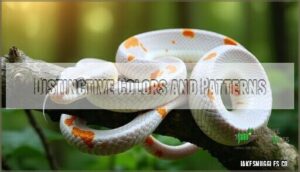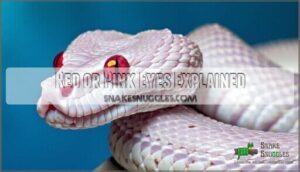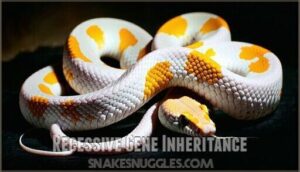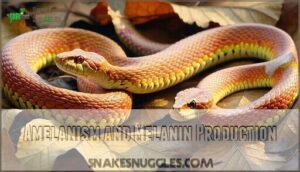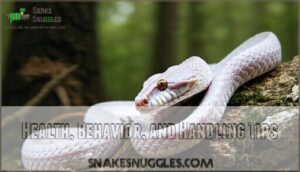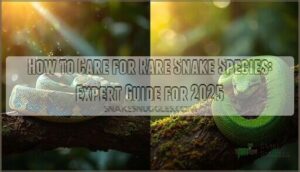This site is supported by our readers. We may earn a commission, at no cost to you, if you purchase through links.
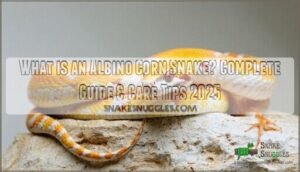
The genetic condition works like a recessive trait, requiring both parents to carry the gene for offspring to display these intriguing characteristics. The fascinating genetics behind their coloration reveals secrets about inheritance patterns that serious breeders use strategically.
Unlike their wild counterparts, these snakes need extra care due to light sensitivity and potential vision issues. Their docile temperament makes them popular pets, though they require specific temperature gradients and humidity levels for ideal health.
Table Of Contents
- Key Takeaways
- What is an Albino Corn Snake?
- Physical Characteristics and Coloration
- Genetics of Albino Corn Snakes
- Care Requirements and Husbandry
- Health, Behavior, and Handling Tips
- Frequently Asked Questions (FAQs)
- How rare are albino corn snakes?
- What does it mean when a corn snake is albino?
- Are albino corn snakes friendly?
- What is the difference between Amel and albino corn snakes?
- How often do albino corn snakes shed their skin?
- Are albino corn snakes more prone to health issues?
- What are the best toys for albino corn snakes?
- Can albino corn snakes be kept with other snakes?
- How do albino corn snakes behave during breeding season?
- Are albino corn snakes more expensive than normal morphs?
- Conclusion
Key Takeaways
- You’ll recognize an albino corn snake by its striking red or pink eyes and vibrant yellow, orange, and red patterns against white backgrounds – this results from amelanism, a genetic condition that prevents melanin production in their scales and eyes.
- You need to understand that albino traits follow recessive inheritance patterns, meaning both parents must carry the amelanistic gene for offspring to display the characteristic lack of black pigmentation and distinctive eye coloration.
- You’ll need to provide extra care for light sensitivity and potential vision issues, including dimmer lighting and careful habitat management, though their docile temperament makes them excellent pets for beginners.
- You can expect your albino corn snake to grow 2-6 feet long with a 15-20 year lifespan, requiring standard husbandry with temperature gradients of 75-85°F, 40-50% humidity, and feeding pre-killed frozen rodents every 7-14 days for adults.
What is an Albino Corn Snake?
You’ll recognize an albino corn snake by its striking red or pink eyes and lack of black pigmentation, which creates vibrant yellow, orange, and red patterns against a white background.
This genetic condition, technically called amelanism, occurs when a recessive gene prevents melanin production in the snake’s scales and eyes.
Definition and Unique Features
An albino corn snake represents one of nature’s most striking genetic variations. These serpents lack melanin production, resulting in vibrant yellow, orange, and red color patterns against white backgrounds. Their distinctive red or pink eyes serve as the hallmark identifier of true albinism.
Unlike typical corn snakes with dark pigmentation, albino traits create mesmerizing skin patterns that captivate reptile enthusiasts worldwide. Understanding the proper snake care guidelines is essential for maintaining the health and well-being of these unique pets.
Difference Between Albinism and Amelanism
True albinism involves complete melanin absence, but corn snakes display amelanism—a genetic disorder affecting only black pigment production. This mutation preserves yellow and red pigments while eliminating dark melanin, creating vibrant color variations.
Unlike human albinism, which affects skin and eyes completely, amelanism in snakes primarily impacts vision through reduced eye pigmentation.
How Albinism Affects Appearance
Without the usual dark pigmentation, you’ll notice your albino corn snake displays a striking transformation. Melanin deficiency creates dramatic changes in appearance, affecting skin, eyes, and overall coloration patterns.
Here’s how albinism transforms your snake’s looks:
- Color Patterns shift from typical browns and blacks to vibrant yellows, oranges, and reds against white backgrounds
- Eye Shine appears distinctly red or pink due to visible blood vessels beneath the clear iris
- Scale Texture remains smooth but shows enhanced contrast between pattern colors and lighter base tones
The absence of melanin makes skin sensitivity to light more pronounced, requiring careful habitat management for your pet’s comfort.
Physical Characteristics and Coloration
When you examine an albino corn snake, you’ll immediately notice its striking appearance differs dramatically from typical corn snakes. These reptiles display vibrant yellows, oranges, and reds against white backgrounds with distinctive red or pink eyes that result from complete melanin absence.
Size and Lifespan
Your albino corn snake will grow steadily from a pencil-thin hatchling to an impressive adult. Growth Rates vary, but most reach 2-6 feet in Snake Length over their 15-20 year Lifespan Expectancy. Age Factors and proper Weight Management directly impact longevity, while their unique albinism affects skin and eyes but not vision-related health outcomes.
| Life Stage | Length | Weight |
|---|---|---|
| Hatchling | 12-15 inches | 6-15 grams |
| Juvenile | 18-36 inches | 50-200 grams |
| Adult | 2-6 feet | 1-2 pounds |
Distinctive Colors and Patterns
Striking color morphs set albino corn snakes apart from their wild counterparts. These serpents showcase creamy white or pale orange skin backgrounds adorned with vivid red, orange, or yellow saddle-shaped markings where melanin would usually create black borders.
Understanding the various corn snake morphs, such as those found in snake morph photos, is essential for appreciating the genetic diversity of these snakes.
- Candy Cane morphs display clean white backgrounds with bright red saddles
- Sunglow varieties feature golden-yellow tones with minimal pattern interference
- Motley patterns create merged circular blotches resembling floral designs
- Scale texture remains smooth while pattern genetics determine saddle distribution
Red or Pink Eyes Explained
You’ll notice your albino corn snake’s eyes appear bright red or pink due to the complete absence of melanin in the iris structure. This Eye Color Genetics trait directly results from amelanistic genes preventing melanin production throughout ocular tissues.
The Melanin Role in normal eye pigmentation creates darker colors, but albinism eliminates this entirely. While striking visually, these Vision Impacts can include light sensitivity and reduced visual acuity, requiring careful Ocular Health monitoring for ideal snake care.
Understanding color pattern genetics is essential for appreciating the unique characteristics of snakes like the albino corn snake.
Genetics of Albino Corn Snakes
You’ll understand albino corn snake genetics through simple inheritance patterns that follow predictable rules.
The amelanistic gene works as a recessive trait, meaning both parents must carry this specific gene for their offspring to display the characteristic lack of black pigmentation and striking red eyes.
Recessive Gene Inheritance
Behind every albino corn snake lies a fascinating genetic story. These snakes inherit their striking appearance through recessive gene inheritance, where both parents must carry the amelanistic gene for offspring to display albino traits. This inherited disorder follows predictable inheritance patterns that breeders use strategically.
- Genetic mutation prevents melanin production, creating the signature white and orange coloration
- Gene expression requires two copies of the recessive allele to manifest albino characteristics
- Hereditary factors make genetic counseling valuable for serious breeding programs
Amelanism and Melanin Production
The amelanism in corn snakes disrupts melanin production through genetic variation, creating their signature hypopigmentation. Unlike true albinism affecting multiple pigments, amelanism specifically blocks melanin genetics while preserving other color pigmentation systems.
This selective melanin production failure results in distinctive snake morphology. Vibrant oranges and reds emerge where black would normally appear, demonstrating how amelanism causes dramatic shifts in natural coloration patterns.
Breeding for Albino Traits
Successful breeding programs require careful genetic selection to produce albino corn snakes. Understanding trait inheritance patterns and color genetics is essential to achieve the desired results. Snake morphology studies help breeders identify carriers of this genetic condition.
- Pair two amelanistic parents – guarantees 100% albino offspring with complete melanin absence
- Cross carriers strategically – produces 25% albino probability while maintaining genetic diversity
- Document breeding records – tracks genetic testing results and prevents inbreeding complications
Care Requirements and Husbandry
You’ll need to provide proper housing, nutrition, and environmental controls to keep your albino corn snake healthy and thriving. Their amelanistic condition doesn’t change basic husbandry requirements, but you’ll want to pay special attention to lighting since their red eyes can be more sensitive to bright illumination.
Enclosure Size and Environment
Your albino corn snake’s enclosure needs adequate Space Requirements of at least 40 gallons for adults. Proper Habitat Design includes secure hiding spots on both warm and cool sides. Ventilation Systems prevent stagnant air while maintaining ideal Humidity Levels between 40-50%. Temperature Control requires a gradient from 75-85°F. Their sensitive skin and eyes need protection from bright lighting due to melanin deficiency affecting vision.
Understanding snake enclosure sizes is vital for creating a suitable environment for your pet.
Diet and Feeding Schedule
You’ll feed your albino corn snake pre-killed frozen rodents thawed to room temperature. Adult snakes eat every 7-14 days, while juveniles need feeding every 5-7 days based on their feeding habits. Choose appropriately sized prey – the rodent should match your snake’s thickest body section.
Fresh water intake remains essential, so provide a shallow bowl that’s cleaned weekly for proper nutrient requirements. The snake’s diet may include a frozen mouse supply.
Temperature, Humidity, and Lighting Needs
Creating proper thermal gradients helps your albino corn snake regulate body temperature effectively. You’ll need basking spots at 90°F and cool zones between 75-82°F. Environmental controls prevent temperature fluctuations that stress these melanin-deficient snakes.
Maintain humidity levels around 40-60% to prevent respiratory issues. Standard lighting cycles support natural rhythms, but avoid intense UV due to their skin and eye sensitivity.
Proper UVB lighting systems are essential for the overall health and well-being of albino corn snakes.
Health, Behavior, and Handling Tips
You’ll need to monitor your albino corn snake’s health closely since their light-sensitive eyes and lack of melanin can create unique challenges.
Understanding their docile temperament and proper handling techniques will help you build a strong bond while preventing stress-related health issues.
Common Health Issues
Vigilance becomes your best friend when monitoring albino corn snakes for health issues. Vision problems and eye sensitivity are common due to albinism affecting melanin production in their eyes.
You’ll need to watch for skin cancer risks since their pale skin lacks protective pigmentation.
Genetic disorders can manifest as respiratory infections or mites, so regular vet checkups help catch problems early before they become serious health risks.
Temperament and Socialization
Beyond their calm nature, corn snakes with albinism form gentle social bonds through consistent handling techniques. Their impaired vision from reduced pigment doesn’t affect snake behavior patterns, though they rely more on scent and vibration.
Environmental Enrichment and Stress Management become essential as their sensitive skin and eyes require careful attention during interactions. Understanding corn snake temperament is essential for providing the best care and handling for these animals.
Safe Handling Practices
Handle your albino corn snake with gentle restraint techniques to avoid stress. Use a snake hook for initial contact, then support the body with both hands. Their sensitive skin and compromised vision from reduced melanin production require extra care.
Handling gloves aren’t necessary but help nervous beginners. For added protection, consider using snake handling gloves to prevent bites.
Always secure the enclosure after handling – escape prevention is essential since their unique coloration makes them vulnerable outdoors.
Frequently Asked Questions (FAQs)
How rare are albino corn snakes?
Surprisingly, you’ll find albino corn snakes aren’t particularly rare anymore. With over 800 recognized morphs and the first being produced in 1961, albinism has become one of corn snakes’ most established color variations.
What does it mean when a corn snake is albino?
When your corn snake is albino, it means they lack melanin production due to a recessive genetic trait called amelanism.
You’ll notice their striking yellow, orange, and red coloration with distinctive red eyes instead of normal dark pigmentation.
Are albino corn snakes friendly?
Like gentle giants in miniature form, albino corn snakes display remarkably calm temperaments. You’ll find they’re naturally docile creatures that rarely bite, making them excellent pets for beginners and experienced keepers alike.
What is the difference between Amel and albino corn snakes?
There’s no difference – "Amel" and "albino" refer to the same genetic trait in corn snakes. You’ll hear breeders use "amelanistic" as the technical term for lacking black pigment, while "albino" is the common name for this beautiful morph.
How often do albino corn snakes shed their skin?
While you’ll think they shed constantly, young albino corn snakes actually shed every 4-6 weeks, while adults only shed every 3 months or so. Growing juveniles outgrow their skin faster than established adults.
Are albino corn snakes more prone to health issues?
You’ll find that albino corn snakes aren’t more prone to health problems than regular corn snakes. **They do face light sensitivity and require dimmer lighting to prevent eye strain, but they’re just as hardy overall.
What are the best toys for albino corn snakes?
Spoiler alert: snakes aren’t exactly toy enthusiasts! Your albino corn snake doesn’t need entertainment gadgets—they prefer hiding spots, climbing branches, and different textured surfaces for enrichment instead.
Can albino corn snakes be kept with other snakes?
You shouldn’t house albino corn snakes with others. Cohabitation risks injury or death from feeding confusion. Corn snakes don’t benefit from company and prefer solitude for peak health.
How do albino corn snakes behave during breeding season?
Like hormones on a rollercoaster, you’ll notice your albino corn snake becomes more active during spring breeding season.
Males will seek out females by leaving scent trails using their pheromones while becoming less interested in food as their focus shifts to reproduction.
Are albino corn snakes more expensive than normal morphs?
Yes, you’ll usually pay more for albino corn snakes than standard morphs. Albinos range from $40-100, while rare combinations can reach $300+ , making them pricier than basic morphs.
Conclusion
Beyond their enchanting beauty lies a fascinating genetic story – what’s an albino corn snake truly represents nature’s artistry through amelanism.
These extraordinary serpents require dedicated care, from managing their light sensitivity to maintaining proper thermal gradients.
You’ll find their gentle temperament makes them rewarding companions when their specialized needs are met. With proper husbandry knowledge and commitment to their unique requirements, you can successfully care for these stunning amelanistic beauties for decades to come.


